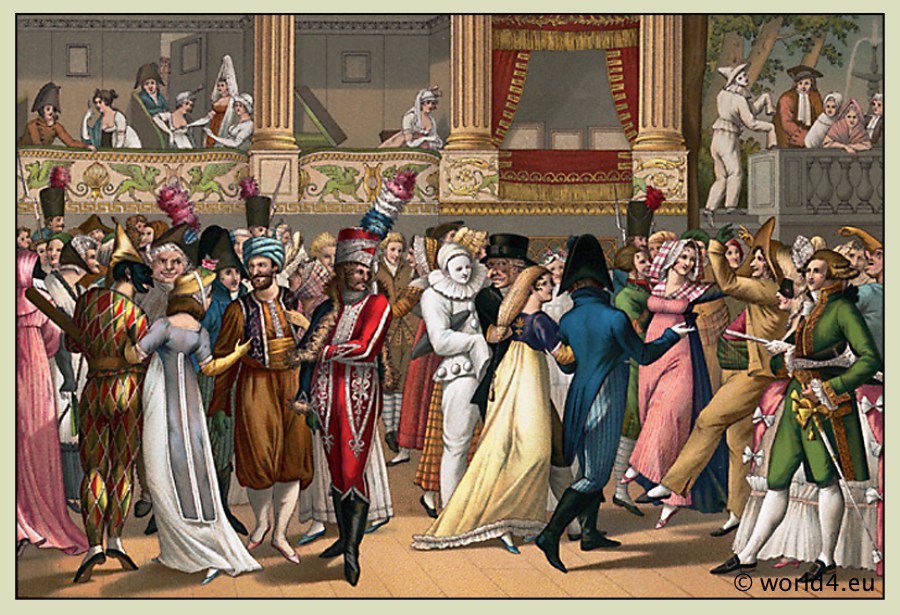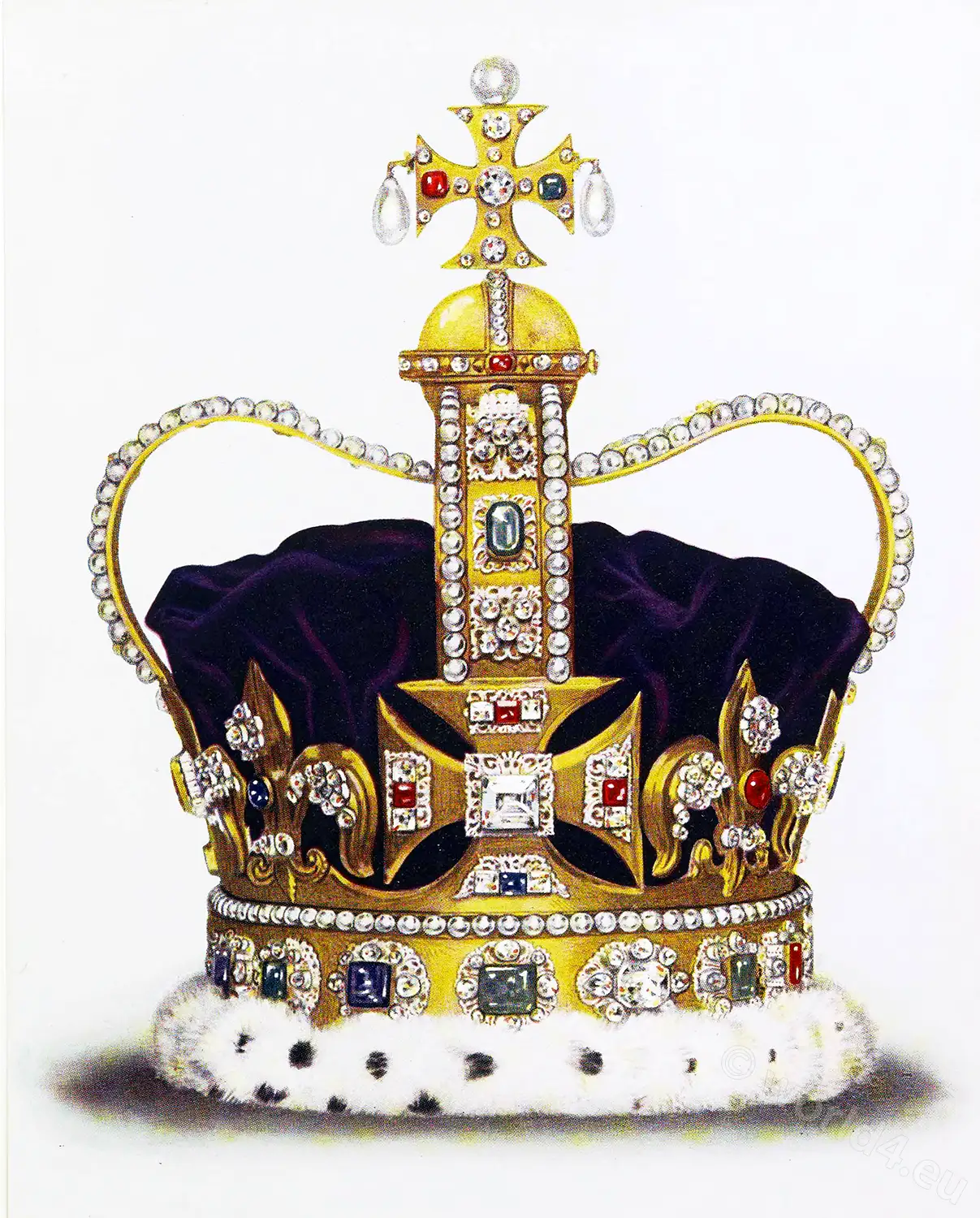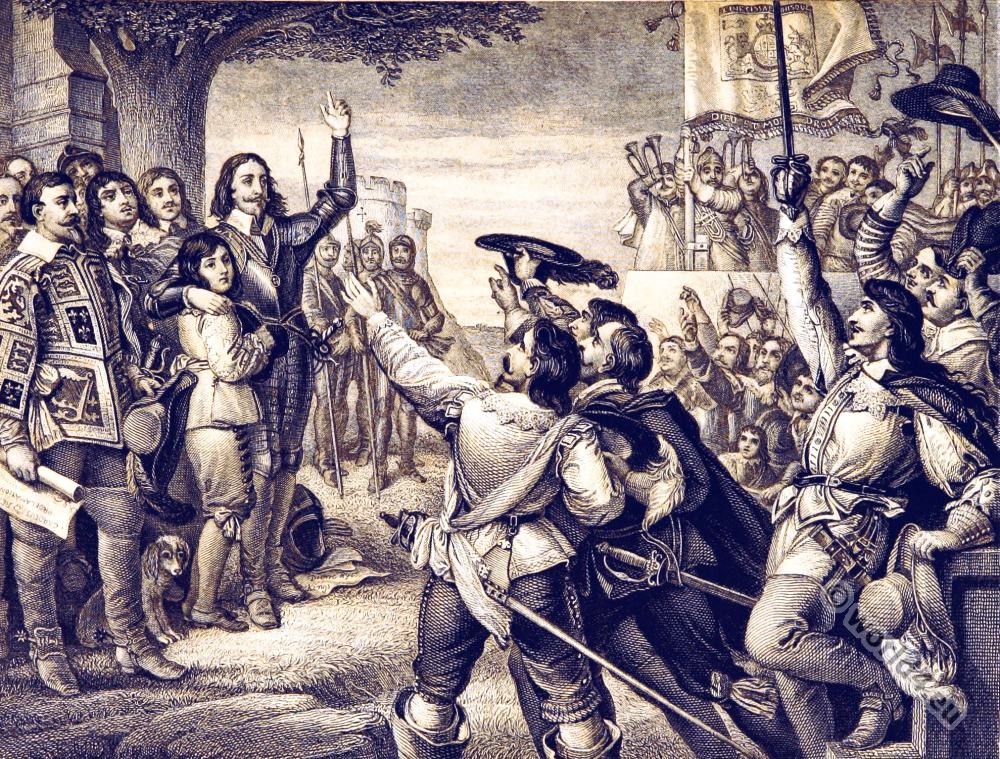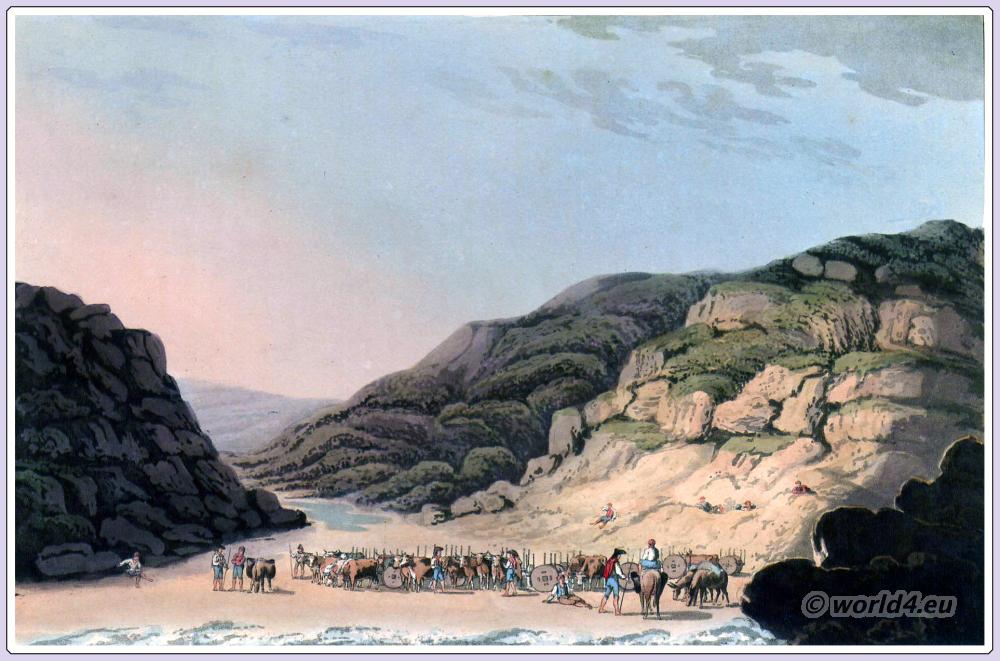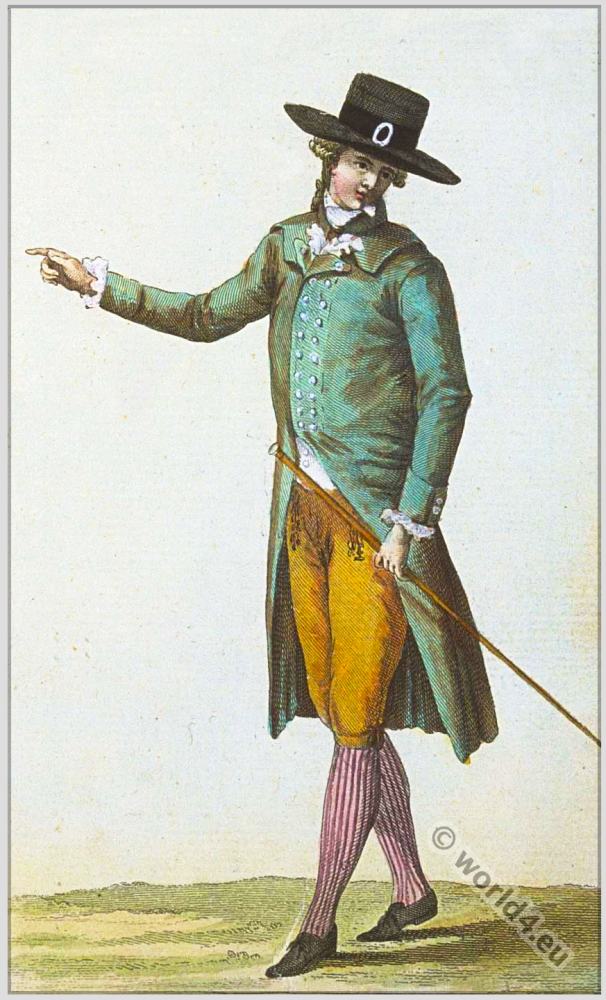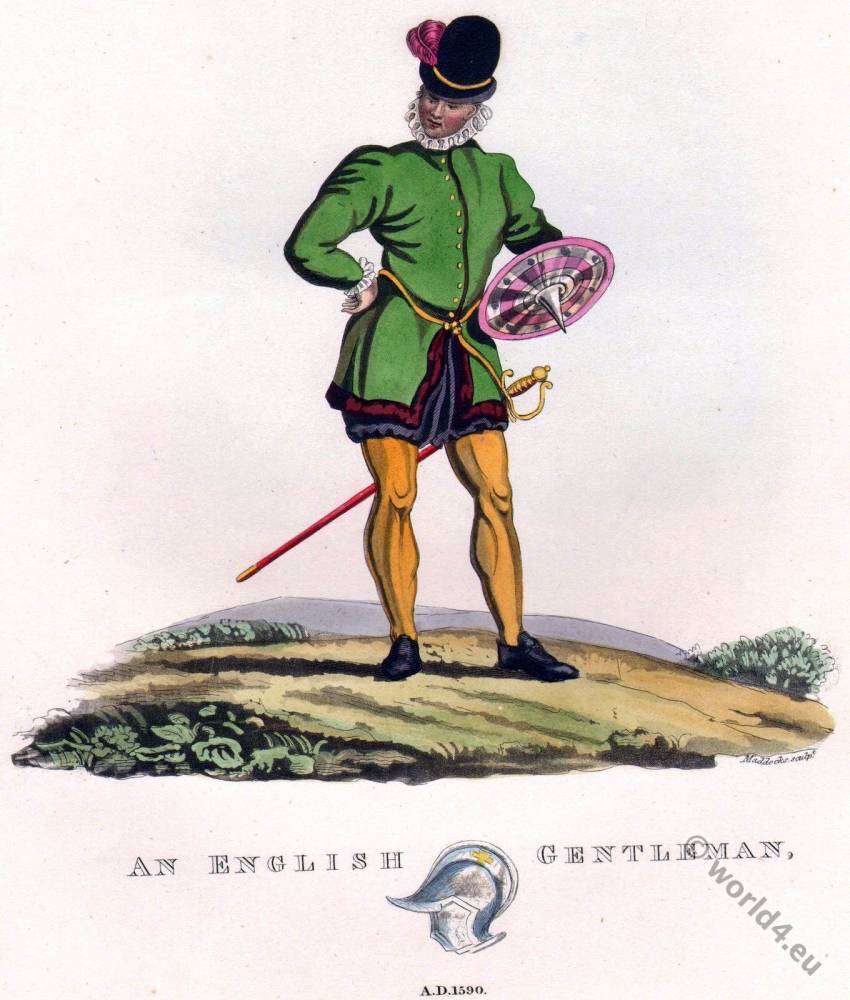Dame Fashion Paris-London by Julius M. Price.
The Regency fashion period 1808-1815. Comparison of the French and English modes.
Pitt’s powder tax. Insular prejudice.
WHILST fashion was thus running riot in France, England was following the new course of things, but somewhat more soberly. Insular prejudice was very strong in those days, and it took a long while to introduce anything foreign from across the Channel. For some time severe polemics on the subject continued between the progressive section and that which was against any upsetting of the old-fashioned English ideas of decorum.
Pitt’s powder tax of 1795 did much to help abolish head-dressing, and to bring in the rational method which is so peculiarly suitable to the English type. That seemingly irritating imposition had been at the time vehemently opposed by the selfsame prejudiced votaries of old and obsolete ideas. Small wonder, therefore, that the mere rumour of the introduction of a fashion which was creating such a furore on the other side of the channel should inspire the liveliest feelings of indignation amongst old-fashioned English folk who had been born and bred with the idea that everything French or coming from France spelt iniquity. With people of such narrow-minded views, there could be no question of admitting the possibility that any innovation from France could be by any chance acceptable, either, from a moral or artistic standpoint.
This curiously insular characteristic of the nation has been shown to be ingrained in the English temperament, and although in these ultra-modern days the tendency has become considerably modified, it has taken several generations, aided by increasing international comity, and the improvement in the conditions of travel, to accomplish it.
However, to return to our subject. The new style at length made its appearance in London, and its advent, which had long been heralded by travellers from the gay city, was hailed with a storm of derision and satire by the journalistic scribes of this country. This, of course, was only what might have been expected, but the innovation had come to stay, in spite of the opposition of the prudes, and the antagonism of the press generally. The most serious efforts of the writers of the period are quite amusing to read in our days, when one can regard the much discussed mode complacently from its artistic and historical aspect only. The following inspiration of an unknown bard is worth reproducing, if only as a specimen of journalistic rhyme in those days:
“Enough of petticoats! Their reign is o’er. Our feet unfettered feel their weight no more – Nought now our free’st movements stops or stays. So boasts the nymph of these enlightened days. Not long ago our dames, averse to freeze, Did wear their petticoats below their knees; But now, not made of such too tender stuff, They scorn all warmth, a fig-leaf is enough – Bosoms and necks and arms have long been bare, And backs, good heavens! how broad I have made you stare. Yet though the world above was given to show, Still there survived some decency below. Oh Boreas! iron tyrant of the North! Call all thy keen artillery instant forth. To thee our hopes make now their last appeal, And if nought else can, thou shalt make them feel. Drive on the Polar ice, increase thy snows, Bring back our women’s senses and their clothes. But gravely-whence this madness? All agree We do not love the more, the more we see. Women,’tis Nature’s law, we must admire; Too great exposure only cools our fire. Howe’er old poets paint the Loves and Graces, Our eyes demand no sample but their faces.”
Regency. The short waist is adopted.
The short waist, when it was at last generally adopted, was a modification of the French style, though it must be added that in certain particulars it was an Improvement on it. The English couturieres had contrived to obliterate much of the originality of the French touch, and had given it an almost English personality, which has been immortalised by the great painters of the school of Sir Joshua Reynolds.
Still the new mode did not meet with universal appreciation for some time, for England was very puritanical in those days, and the scantiness of the draperies was calculated to shock the old-fashioned folk, who were perhaps the more prejudiced through their hereditary detestation of everything French.
In a contemporary magazine article on the dress of the period a writer gives an Idea of the prevailing sentiment. “It is impossible,” he says, “to advert to the state of female manners without noticing a still more melancholy proof of the decay of those feelings which are the grand bulwark of female virtue, than even a growing indifference to the character of those who are admitted into the parties of fashionable life.” He then somewhat unnecessarily adds that he refers, of course, to the indecent modes of dress which are becoming more and more prevalent among women of all classes. These modes, and indeed the whole style of fashionable female dress at that time, he denounces, “as evidently invented by the most profligate of the sex for the purpose of exciting sensuality and inflaming passion that stand in the greatest need of restraint. They have been adopted by women who lay claim to unsullied reputations, and by them are transmitted to the lowest ranks of female society.”
Comparison of the French and English modes
This reads in our days as very acrimonious comment, but it reflected the narrow-minded and strait-laced public opinion of the time, an a totally unfounded apprehension that what was taking place in Paris would be repeated in London without taking into account the difference of temperament of the two nations. Under no conceivable social conditions could Englishwomen let themselves go, so to speak, to the extent the French did during the Directoire, and a comparison of the modes of the time sufficiently corroborates this.
One notes that whilst the suggestion of ancient Greece is still retained, it is in so modified a form as to harmonize with Anglo-Saxon characteristics, the result being often very beautiful in its simplicity. The masterpieces of the great English portrait-painters of that epoch, Henry Raeburn and Sir Thomas Lawrence, are assuredly very more convincing in this respect.
There is in them none of the suggestiveness one remarks in contemporary French painters of the new fashion. And this is somewhat the more surprising when we remember that the famous French Court dressmaker and milliner Mademoiselle Bertin had taken up her abode in London during the Revolution, and had brought all her Paris work-girls with her; so it is highly probable that all the most fashionable women of England must have profited by her new establishment.
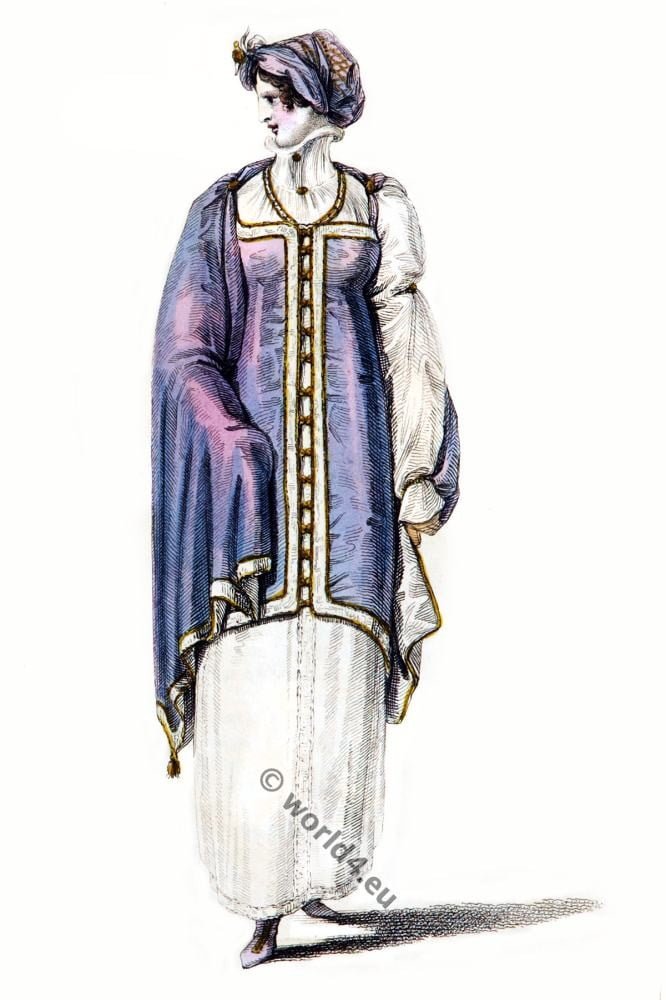
After the Directoire was abolished, and with the advent of the Consulate, a curb was put upon the licentious state of affairs in the world of fashion which had existed in Paris for five years. The dress of the fair gender now became slightly more decorous. Long trains were still seen, and a somewhat subdued classic drapery, but with handsome embroidery, whilst Indian and Cashmere shawls gradually replaced the pélisses and spencers; muslin handkerchiefs or ruffs were worn round the neck in evening dress.
The hair was drawn in tight and very becomingly to the head by a fillet of velvet or gold brocade, and often surmounted by white feathers-in fact the style of arranging the hair has never been more attractive than at this period: Turbans were the favourite headgear at this time, and it is here of interest to note how the different temperaments of the French and English women displayed themselves at this period.
In France the victories of Napoleon’s armies aroused but slight response in Paris, whilst in Patriotism whether from national pride or patriotism, the prowess of the army or navy excited the utmost enthusiasm, and this was shown in a variety of forms, not the least interesting from the standpoint of feminine fashion being the manner in which the names of great commanders would be inscribed in large letters across the front of the all-fashionable turban. Amongst other millinery in vogue, bonnets, hats, and various other arrangements were to be seen in a variety of shapes.

Fashions in Paris during the early years of the century changed so frequently and with such slight alterations that it is almost impossible to enumerate them, though, as compared with the Directoire period, there are many features of interest to be noted. There was a tendency towards wearing Eastern draperies which was probably suggested by Napoleon’s Egyptian campaigns, and this is the only indication we have of any interest having been taken in Paris in connection with the mighty deeds of the French armies.
Another note of colour in costume was supplied by long scarves of bright coloured silk draped over the shoulders or hung over the arms. These scarves were frequently edged with valuable fur. About this period one notices round the hem of the skirts a suggestion of the frills which were to assume such grotesque proportions later on. Sunshades of a peculiar shape now began to come into fashion. Jewellery was much worn: long ear-rings especially, and there was a craze for diamonds and topazes.
The Empire, though it brought about great social changes in France, did not, at least for the first year or so of its existence, alter the fashion to any marked extent. The tendency for some time was still towards the antique and the relatively nude, but with the return of a Court, with all its imposing functions and State etiquette and festivities, women’s dress gradually became more elaborate, and at length reached a point when for magnificence it has never been surpassed.
The Oriental style was especially copied; richly embroidered muslins, drapery interwoven with gold and silver, or decorated with garlands of flowers, and a profusion of jewellery completed the attire of the fashionable women towards the close of the Empire period – an attire which was certainly not the least remarkable of the many changes during the evolution of fashion in the previous fourteen years.
In England fashion levied a very heavy tax on its votaries, and one is astonished at the extravagance displayed by many English ladies of the grand monde at a time when England was disturbed by internal polemics; the King’s condition was inspiring grave anxiety, and we were at war with France.
As an instance of the extravagance in dress, we might take the following description of a dress of the period: “The nuptial dress of Mrs. Wellesley Pole excelled in costliness and beauty the celebrated one worn by Lady Morpeth at the time of her marriage, which was exhibited for a fortnight at least by her mother, the late Duchess of Devonshire. The dress of the present bride consisted of a robe of real Brussels point lace, the device a single sprig; it was placed over white satin. The head was ornamented with a cottage bonnet of the same material, namely Brussels lace with two ostrich feathers. She likewise wore a deep lace veil, and a white satin pelisse trimmed with swansdown. The dress cost 700 guineas, the bonnet 150, and the veil 200. Her jewels consisted principally of a brilliant necklace and ear-rings; the former cost twenty-five thousand guineas.” As a sort of counterbalance to this inordinate expenditure we are told, however, that “Every domestic in the family of Lady Catherine Lucy has been liberally provided for. They all have had annuities settled on them for life, and Mrs. Wellesley Pole’s own waiting-woman, who was nurse to her in her infancy, has been liberally considered. The fortune remaining to Mrs. Wellesley Pole may be raised to eighty thousand per annum.”
Regency. First Empire. Current modes of the time: prevailing colors.
The above description, of course, only refers to a toilette for a particular occasion, as it simply gives us a general idea of the current modes of the time; we learn, however that the prevailing colours during these years were red, green, lilac or heliotrope, buff, pink, and blue, all of the very palest shades. In the morning, spencers of the above colours in figured sarsenet over a ‘white cambric dress were in fashion; some ladies wore a dress of muslin or linen of the same shade as the spencer and trimmed with three rows of narrow ribbon. Half-boots to lace behind came in. Round hats with flat crowns were still in fashion; a flower under the brim being the favourite ornament, with a ribbon simply tied round the crown.
Regency Full Dress. Hair-dressing. Jewelry.
The full dress of these times consisted of a demi-vest of sarsenet, the colour of ripe corn, irradiated from the centre of the waist, with rays of star-points, connected with small brooches of pearl or silver studs. It was trimmed round the bottom with broad rich lace; the epaulettes of the vest had short sleeves of the same lace. The underdress was of white lustring, and the mantle or shawl of purple crape, spotted with large silver spangles or stars. These detached draperies were much admired, as contributing greatly to elegance of form, and furnishing an excuse for graceful positions of the arms. The necklace was of pearls, and double, with intermediate medallions.
The hair was dressed in irregular curls round the face with a coronet à la Fanon of plate gold burnished and set with silver stars. The back of the hair, except for two or three small ringlets, was drawn up into a great net. The shoes and gloves were of white kid, and the bracelets to match the necklace. Various head-dresses and jewellery were worn, all equally becoming, as for instance the following – a Grecian head-dress with several rows of large pearls continued round the hair. With this went a necklace, earrings, and bracelet of pearls somewhat smaller than those on the head.
Fashion in Paris. The Restoration. Fashions in hats. The English in Paris after Waterloo.
After the Restoration in 1814, as might be expected, we find that the modes show a tendency towards a more sober style, in keeping with the changed political and social situation. In Paris at this time the great anxiety of all these elegant ladies appears to have been as to the choice of suitable hats, and it is said that between the Restoration and 1830 one could have easily found ten thousand different shapes in the capital and what hats! One has but to glance at the accompanying plates to admit that an adequate choice from such a selection was indeed difficult to make.
The presence of the Allied troops in Paris brought in a vogue for English, Russian, or Polish military head-dresses, and this, curiously enough, without arousing any anti-foreign feeling on the part of the French people. As a result “Chapeaux à la Russe,” It à l’Anglaise,” and so forth were quite a la mode for a time. What a change one year had made in the aspect of Paris, Lady Brownlow tells us.
In 1814 there was a small sprinkling of English; in 1815 there was an English army, and the Duke and Duchess of Wellington established in a grand hotel where they gave dinners and balls. Lord Hill in the Hôtel Montesquin, Lord Stewart in the Montmorency, Sir L. and Lady F. Cole quartered in Madame Junot’s hôtel, with Lady G. Bathurst as their guest, Lord and Lady Combermere at the Malmaison, and Sir Andrew Barnard, the English Commander of Paris! And last, though not one of the least of the curiously interesting sights of that curious time, was to see the simple, unpretending demeanour of the english soldiers, who sauntered along as unconcernedly as they would have done in London.
Empire Costumes 1815. Fashion in Paris. Paris crowded with English.
Troops of English flocked to Paris; many stayed only short time, and proceeded on to Italy, but many remained, and a lot ‘of entertaining and gaiety took place. Lord Castlereagh, who was in Paris to take part in deliberations of the French and Allied Ministers, was joined later by Lady Castlereagh, and their fine hôtel in the Champs Élysées soon became the rendezvous for all the distinguished foreigners and the fashionable world of the Capital. “Excepting on Sundays,” says Lady Brownlow, “or when there was a ball, Lady Castlereagh went most evenings to one of the theatres. She had boxes at four – the Grand Opéra, the Français, the Fédeau, and the Variétés, On her return from the theatre she received, and had a supper in the same way as in the preceding year; but how far more brilliant were the parties of 1815, both as to their number and the rank of those who attended them! Waterloo, curiously enough, brought about a new era of prosperity for and gaiety for Paris”

Madame de Staël in Paris.
Gronow (Captain Rees Howell Gronow (1794–1865). English dandy and a writer of celebrated reminiscences, who gambled and duelled), in his Reminiscences, tells us that he frequently met the famous Madame de Staël in Paris during years 1815 and 1816. She was constantly at Madame Cranford’s in the Rue d’Anjou Saint-Honoré, and at ‘Lady Oxford’s in the Rue de Clichy. She was very kind and affable to all the English and delighted to find herself, as she puts it, once more in sight and smell of the “ruisseau de la Rue du Bal,” which she once said she preferred to a all the romantic scenery of Switzerland or Italy. She was, we are told, “a large, masculine-looking woman, rather coarse, and with a thoracic development worthy of a wet-nurse. She had very fine arms, which she took every opportunity of displaying, and dark, flashing eyes, beaming with wit and genius.” Admirable as her writings were, her conversation surpassed them. She was “well up” on every subject. “Nihil quod tetigit non ornavit.” Her Salons were filled with all the most celebrated persons of her time. Madame de Staël was, from all accounts, a little overpowering, and totally deficient in those “brilliant flashes of silence” which Sydney Smith once jokingly recommended to Macaulay.
Fashion in Paris. Return of Royalty. The Tuileries. Ball dresses.
With the return of Royalty, and with it a Court, the Salons of the Tuileries were always crowded. Balls and entertainments of all sorts now being continually given in the Faubourg Saint-Germain. Such festivity naturally gave a marked stimulus to trade, with the result that business everywhere was flourishing, so this was sufficient excuse for any extravagance. Paris at this time could boast four ladies’ tailors of renown, thirteen modistes with big clientèles, seven remarkably good florists, three corsetières much in request, and eight ladies’ bootmakers. In either private or official balls white dresses ornamented with flowers round the skirt were usually worn.
The dancers wore flowers in their hair, more especially roses. One saw dresses “à l’Écossaise,” dresses trimmed with chinchilla. The accessories varied much, yet although the general effect was not unpleasant there were not wanting indications that the delightful semiclassic costume of the preceding years was gradually being ousted by a less graceful mode. Sometimes the sleeves were full, and raised up with several layers of “ruches,” or else they were slightly puffed at the shoulders. This was the commencement of a new shape which was gradually to develop into the hideous “leg of mutton” sleeve of a few years later.
The stye principally in vogue at this period was graduated down to the wrist, where it was fastened with a ribbon, and the finishing touch was given by colored kid gloves. For evening wear low-necked dresses with a showy necklace of precious stones were “de rigueur”. The sleeves were seldom more than puffs at the shoulders, and long gloves reaching only to the elbows were worn, with somewhat incongruous effect. These gloves, which were often made of chamois leather, were very expensive, but no coquette would have dreamed of wearing them more than once as they had to be perfectly speckless. For less dressy occasions short lace capes or berthas were fashionable, and in summer light scarves of the same material as the dress. In hats the poke bonnet remained in favour adorned with a high tuft of flowers or feathers on the front or side and a chin-strap of ribbon. Jewellry in various forms (diamonds, sapphires, rubies, and garnets especially), flowers in sprays and bunches, valuable fans, reticules embroidered in passementerie, completed the toilette of an élégante in Waterloo year.

London 1816. Fêtes to celebrate the Restoration. The Caledonian Ball.
In the meanwhile, “all the embassies in London vied with each other in the splendour of their several fêtes to celebrate the Restoration,” says Lady Clementina Davis in her “Recollections of Society in France and England.” Balls and parties rapidly succeeded each other, but, by many foreigners of distinction at that time in England, the Caledonian Ball was considered the most remarkable. The Highland costume worn upon this occasion by all Scottish gentlemen was strange to Continental eyes. Each chieftain wore his own tartan, and the combination of color was dazzling.
More amazing still to the uninitiated were the Scottish country dances, and particularly the reel, with its rapid steps, its Highland fling, and the wild yell of triumph like that of the Red Indian, shouted forth by its dancers. “At that ball all Scotch ladies likewise wore their national costume according to clan, and my cousin, Mrs. Drummond Burrell, wore the Drummond tartan dress, trimmed with gold fringe, while I, who accompanied her, felt by no means displeased at myself, arrayed as I was in white trimmed with Drummond tartan, shoes to match, and a scarf of the same plaid fastened with a large brooch on the left shoulder.”
London was exceptionally gay after the proclamation of peace, and festivities were the order of the day. Amongst the many vivid descriptions which have been given of the London of that date and of the scenes in the Hyde Park during the Season, not one of the least interesting is that given by Gronow: it presents a realistic picture of the fashion of the time. The company, he says, which congregated about five o’clock, was on week-days composed of ladies and gentlemen of the best society, ordinary folk modestly contenting themselves with putting in an appearance on Sundays only. The ladies used to drive into the Parkin a “vis-à-vis”– a carriage which held only two persons. The hammercloth, rich in heraldic designs, the powdered footmen in smart liveries, and a coachman who assumed all the gravity and appearance of a wigged archbishop, were indispensable. These equipages were much more gorgeous than at a later period, when democracy invaded the Parks, and introduced what may be termed a “Brummagem society,” with shabby-genteel carriages and liveries.
Amongst the most famous beauties were the Duchesses of Rutland, of Argyll, of Gordon, and of Bedford; the witty Marchioness of Conyngham; the Ladies Cowper, Anglesey, Foley, Heathcote, Lambton, Hertford, and Mountjoy. Pretty horse-breakers and ladies of the demimonde would then as soon have thought of going to a Drawing Room as showing themselves in Hyde Park on week-days. Nor did any of the lower or middle classes think of intruding themselves in regions which, with a sort of tacit understanding, were given up exclusively to rank and fashion.
Source: Source: Dame Fashion Paris-London (1786—1912) by Julius M. Price. London Sampson Low, Marston & Company, 1913.
Related
Discover more from World4 Costume Culture History
Subscribe to get the latest posts sent to your email.








